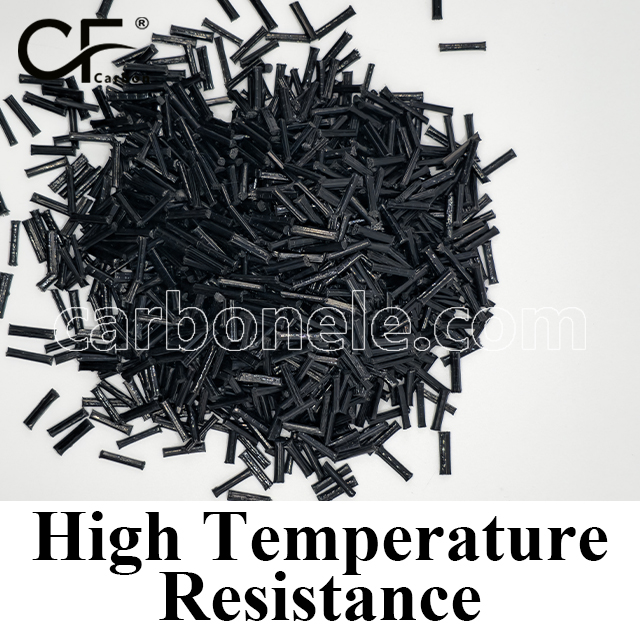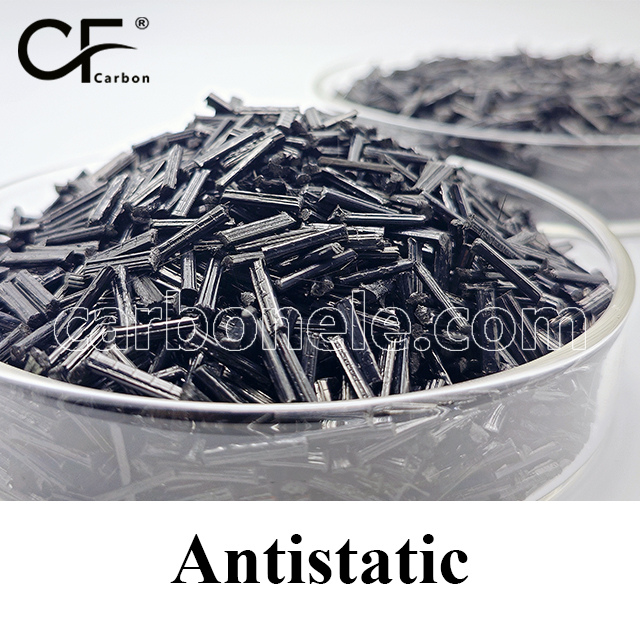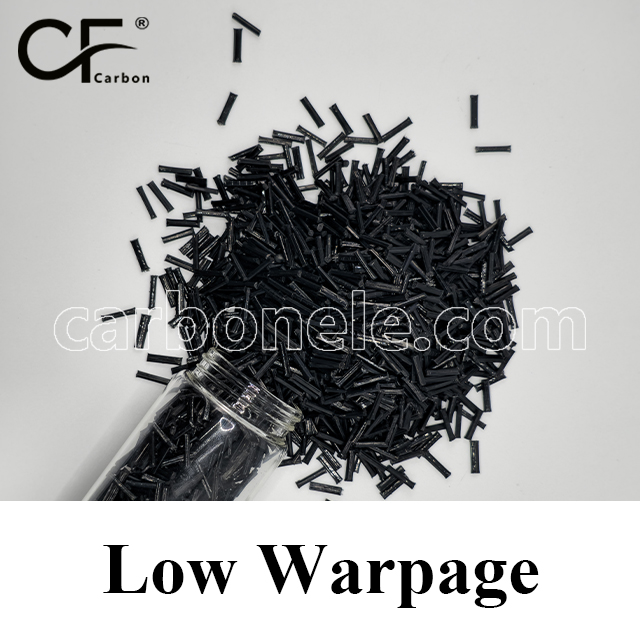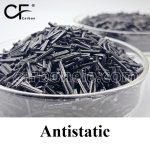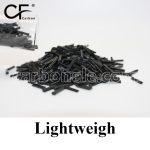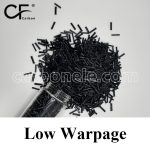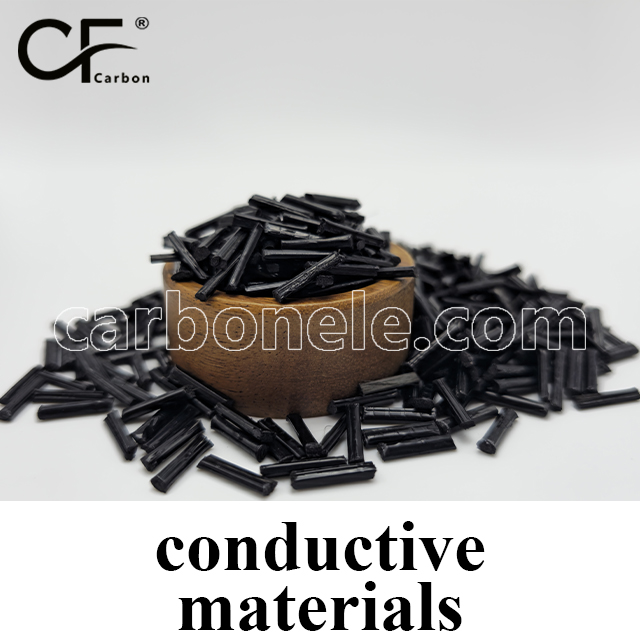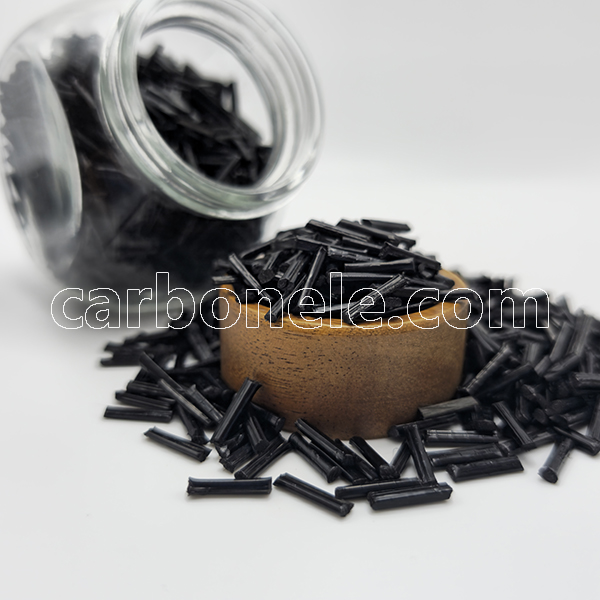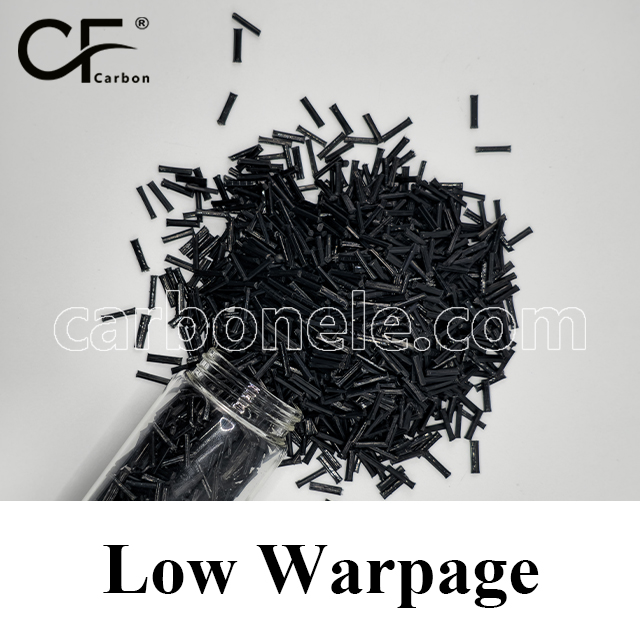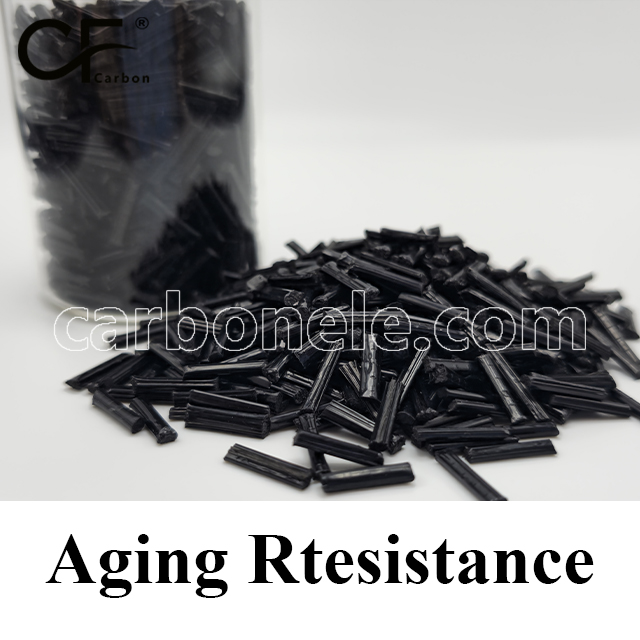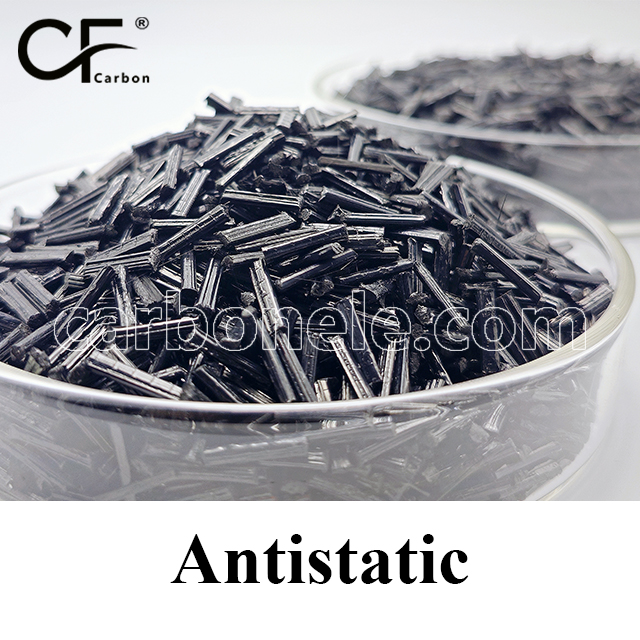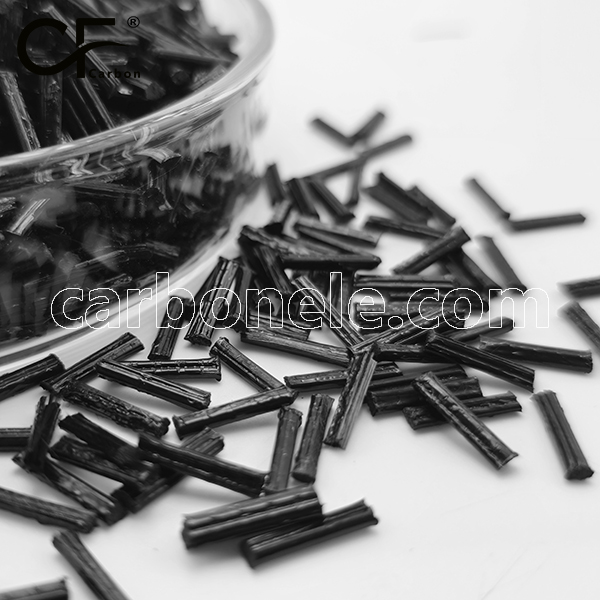PA66-LCF10 is a long carbon fiber reinforced polyamide 66 offering enhanced strength, stiffness, and impact resistance. Ideal for lightweight structural parts, it provides excellent thermal stability, reduced moisture absorption, and superior fatigue performance in automotive, industrial, and mechanical applications under dynamic and high load conditions.

Advanced PA66-LCF10 thermoplastics for friction
- Model number: PA66-LCF-BCA1
- Matrix Resin: Nylon6 6(Polyamide66) (PA66)
- Reinforcing Filler: Carbon fiber
- Appearance: Granules
- Grade: Injection/extrusion grade
- Packaging: 25kgs/bag
PA66-LCF10: High-Performance Long Carbon Fiber Reinforced Polyamide 66 for Lightweight Durability and Thermal Stability
PA66-LCF10 is a high-performance engineering thermoplastic, based on polyamide 66 (PA66) and reinforced with 10% long carbon fiber (LCF). This material is engineered to deliver significantly improved strength, stiffness, and thermal stability while maintaining a lightweight profile and excellent processability. The use of long carbon fibers—as opposed to short or chopped fiber alternatives—results in enhanced load transfer, better fatigue resistance, and superior dimensional control under mechanical and thermal stress.
This formulation strikes a perfect balance between structural integrity and design flexibility, making PA66-LCF10 ideal for medium load bearing components, semi structural parts, and performance critical applications in automotive, electronics, industrial, and consumer product sectors.
Key Mechanical Properties
Tensile Strength: ≥ 105 MPa
Flexural Strength: ≥ 140 MPa
Notched Impact Strength: ≥ 10 kJ/m²
With 10% long carbon fiber reinforcement, PA66-LCF10 outperforms unreinforced and short fiber reinforced PA66 in mechanical strength and toughness. The long fibers create a stronger internal structure, which helps to distribute stress more evenly, reducing the likelihood of failure due to mechanical shock, repeated loads, or vibration. This makes it particularly suited for parts subject to dynamic or fluctuating forces.
Thermal and Chemical Resistance
Heat Deflection Temperature (HDT): Approx. 130°C
Long Term Service Temperature: Up to 120°C
Chemical Resistance: Excellent resistance to oils, greases, fuels, and weak acids; moderate resistance to alkalis; not recommended for concentrated acids or strong oxidizers
PA66-LCF10 retains mechanical stability at elevated temperatures, making it reliable for components that must operate in hot environments such as engine bays or industrial machinery. Its chemical resistance profile supports use in chemically aggressive conditions, including exposure to lubricants, coolants, and automotive fluids.
Wear Resistance and Processability
Wear Resistance: Strongly enhanced compared to standard PA66 and short fiber filled alternatives
Processing Methods: Injection molding (LCF compatible equipment), compression molding
Processing Notes: To maximize fiber retention and mechanical performance, low shear settings and hardened steel molds are recommended. Uniform fiber dispersion across the molded part is critical for consistent properties.
The long carbon fibers significantly enhance surface durability and reduce creep under sustained loads. This makes PA66-LCF10 an excellent candidate for sliding parts, structural guides, support brackets, and other components exposed to repeated movement or mechanical interaction.
Despite its fiber reinforced nature, PA66-LCF10 remains highly moldable and does not require drastic modifications to standard PA66 processing protocols. Specialized long fiber feeders help ensure consistent fiber length and performance.
Environmental Stability
Water Absorption: Reduced compared to unfilled PA66
Dimensional Stability: Excellent—retains geometry in fluctuating thermal and humidity conditions
Due to the hydrophilic nature of polyamide, moisture uptake often affects dimensional control. However, the presence of long carbon fibers in PA66-LCF10 reduces water absorption significantly, minimizing warping and swelling. This stability is crucial in precision assemblies or applications requiring long term structural accuracy, particularly in humid or wet environments.
Typical Applications
PA66-LCF10 is designed for functional components that require enhanced mechanical strength, long term durability, and consistent performance in varying environmental conditions. Its mechanical and thermal profile make it an optimal solution across several industries:
Automotive
Brackets and mountings in engine compartments
HVAC system supports
Lightweight reinforcements and under hood clips
Industrial Equipment
Mechanical levers, support arms, and housings
Gears, bearing cages, and high load bushings
Dynamic components subject to fatigue loading
Electronics & Consumer Goods
Internal structures for small appliances
Rugged casings and mounts
Mechanically active fixtures requiring precise tolerances
PA66-LCF10 Performance Summary
| Property | Value/Description |
|---|---|
| Carbon Fiber Content | 10% (Long Carbon Fiber) |
| Tensile Strength | ≥ 105 MPa |
| Flexural Strength | ≥ 140 MPa |
| Notched Impact Strength | ≥ 10 kJ/m² |
| Heat Deflection Temp. | Approx. 130°C |
| Long Term Service Temp. | Up to 120°C |
| Chemical Resistance | Excellent, except for strong acids/oxidizers |
| Water Absorption | Lower than unreinforced PA66 |
| Processing Methods | Injection molding, compression molding |
| Wear Resistance | High – ideal for load bearing components |
If you want to get more information about PA66-LCF10, you can vist our Youtube.
Click here to contact us.
Strength between PA66 and PA66-CF
Compared to unreinforced PA66, PA66-CF (carbon fiber reinforced) offers significantly higher strength and stiffness. The addition of carbon fiber increases tensile and flexural strength, enhances dimensional stability, and reduces deformation under load. While standard PA66 provides good toughness and impact resistance, PA66-CF materials are better suited for structural and high-stress applications where superior mechanical performance is required.
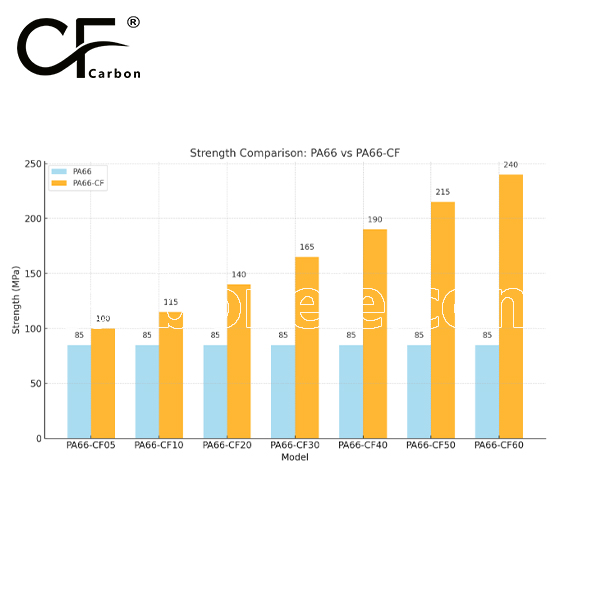
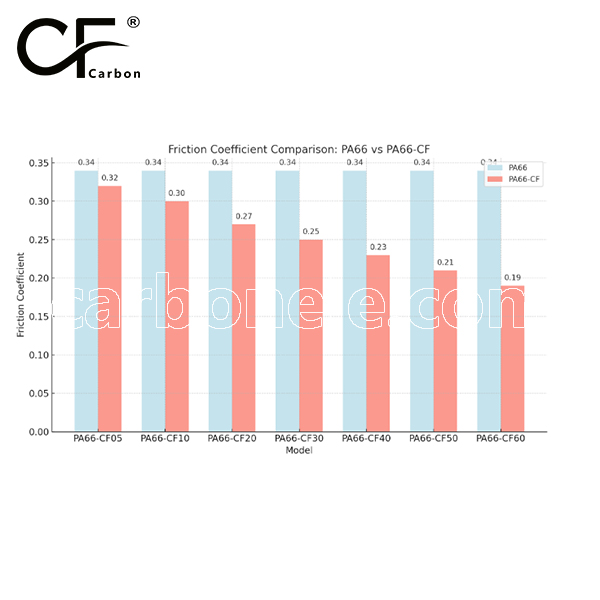

Frequently Asked Questions
Carbon (Xiamen) New Material Co., Ltd. aims to provide buyers with "one-stop" worry-free high-quality services. Here you can find all information about carbon fiber engineering plastics. If you still have questions, please send us an email for consultation!
-
How can I contact the manufacturer of a product that interests me?
When you find a product you are interested in, you can contact the manufacturer directly by sending an email and we will get back to you as soon as possible.
-
How do I find the products that interest me?
All you need to do is enter the keyword, product name in the search window and press the Enter key on your keyboard. Your search results page will then be displayed. You can also search within the product category pages on the home page. Each category is divided into subcategories, allowing you to refine your search and find products that interest you.
-
Where will I find a buying guide?
Please contact our after-sales service directly and we will provide you with a comprehensive operating guide.
-
What are CF Reinforced Thermoplastic Composites?
CF Reinforced Thermoplastic Composites are materials where carbon fibers are incorporated into a thermoplastic matrix. They combine the strength and stiffness of carbon fibers with the processability and recyclability of thermoplastics. For instance, they are used in automotive parts like bumper beams.
-
What are the benefits of CF Reinforced Thermoplastic Composites over traditional composites?
The key benefits include faster production cycles, easier recyclability, and better impact resistance. They also offer design flexibility. An example is in the manufacturing of consumer electronics casings where complex shapes can be achieved more easily.
-
How are CF Reinforced Thermoplastic Composites processed?
Common processing methods include injection molding, extrusion, and compression molding. Injection molding is widely used for mass production. For example, in the production of small components for the medical industry.
-
What industries use CF Reinforced Thermoplastic Composites?
They are utilized in aerospace, automotive, medical, and sports equipment industries. In aerospace, they can be found in interior components. In the medical field, they might be used in prosthetics.
-
How does the carbon fiber content affect the properties of the composites?
Higher carbon fiber content generally leads to increased strength and stiffness but may reduce ductility. A moderate content is often balanced for specific applications. For example, a higher content might be preferred in structural parts of a race car.
-
What are the challenges in using CF Reinforced Thermoplastic Composites?
Challenges include higher material costs, complex processing equipment requirements, and ensuring uniform fiber dispersion. Issues with adhesion between the fibers and the matrix can also arise. An example is in achieving consistent quality in large-scale production.









